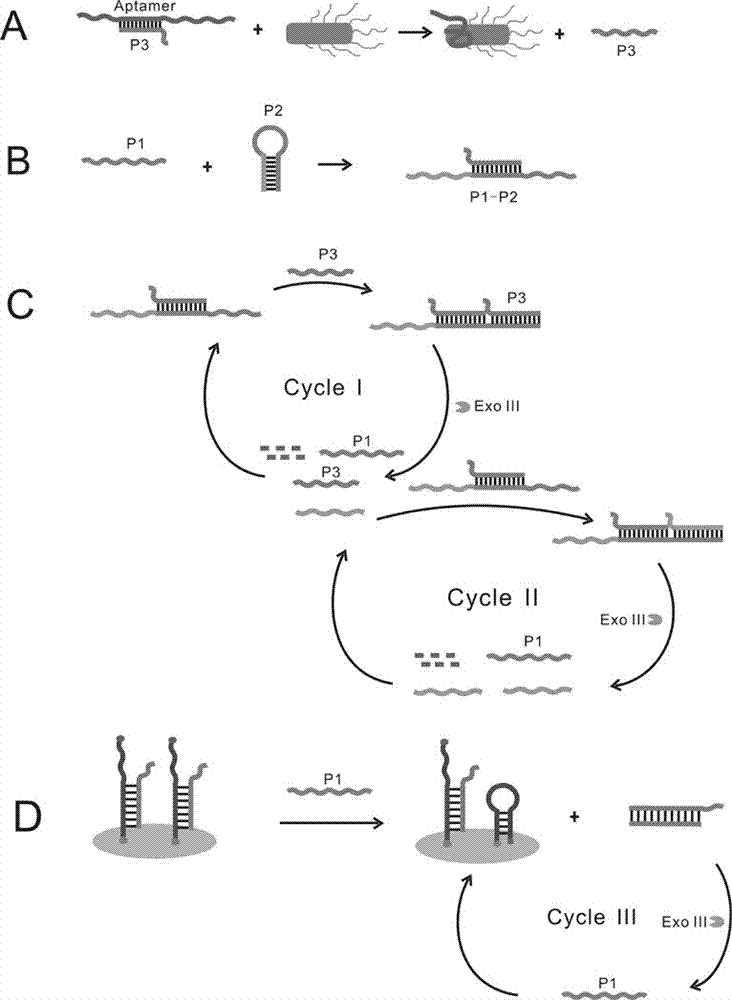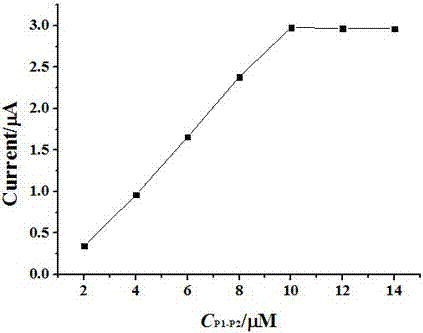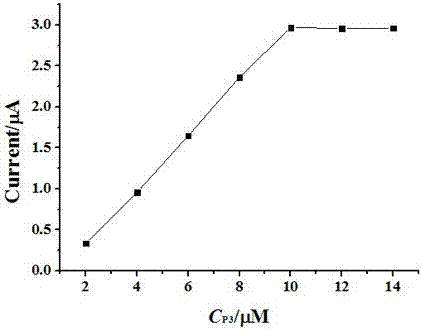Salmonella typhimurium detection biosensor
A biosensor, Salmonella technology, applied in the field of biosensors, can solve the problems of time-consuming and complicated instrument operation, and achieve the effects of improved sensitivity, good repeatability, and mild reaction conditions
- Summary
- Abstract
- Description
- Claims
- Application Information
AI Technical Summary
Problems solved by technology
Method used
Image
Examples
preparation example Construction
[0049] The preparation method of described biosensor comprises the following steps:
[0050] (1) Pretreatment of the electrodes;
[0051] (2) Modify the mixture of iDNA and Helper on the electrode surface;
[0052] (3) Modification of homogeneous reaction products onto the electrode surface.
[0053] In the preparation method, the operation steps of modifying the mixture of iDNA and Helper to the surface of the electrode are preferably as follows: add 10 μL of the mixture of iDNA and Helper dropwise to the pretreated electrode surface, and incubate at 37 °C for 2 h .
[0054] In the preparation method, the preferred steps of modifying the homogeneous reaction product onto the electrode surface are as follows:
[0055] (1) Add 14 μL of sterilized water, 2 μL of 10× buffer, 2 μL of 10 μM P1 and 2 μL of 10 μM P2 into a centrifuge tube, shake for 30 s, place in a thermostat at 90 °C for 10 min, and cool naturally to room temperature;
[0056] (2) Add 12 μL of sterilized water...
Embodiment 1
[0063] The main steps of the electrode modification process are as follows:
[0064] a. The gold electrode is first polished in 0.3 and 0.05 µm alumina slurry until it becomes a mirror surface, and then rinsed repeatedly with PBS and secondary water;
[0065] b. Drop 10 μL of the mixture of iDNA and Helper (10 μM) onto the electrode surface, and incubate at 37 °C for 2 h. Fix the sulfhydryl chains to the electrode surface through Au-S bonds;
[0066] So far, the modification process of the electrode has come to an end. The following describes the reaction in the homogeneous solution and the main steps in the homogeneous reaction:
[0067] a. Add sterilized water, 10× buffer, P1 and P2 (2 μM, 4 μM, 6 μM, 8 μM, 10 μM, 12 μM, 14mM) into the centrifuge tube, shake for 30 s, and place in 90 ℃ in an incubator for 10 min, and naturally cooled to room temperature;
[0068] b. Add sterilized water, 10× buffer, aptamer, P3 and the target object to be tested into the centrifuge tube, ...
Embodiment 2
[0079] The main steps of the electrode modification process are as follows:
[0080] a. The gold electrode is first polished in 0.3 and 0.05 µm alumina slurry until it becomes a mirror surface, and then rinsed repeatedly with PBS and secondary water;
[0081] b. Drop 10 μL of the mixture of iDNA and Helper (10 μM) onto the electrode surface, and incubate at 37 °C for 2 h. Fix the sulfhydryl chains to the electrode surface through Au-S bonds;
[0082] So far, the modification process of the electrode has come to an end. The following describes the reaction in the homogeneous solution and the main steps in the homogeneous reaction:
[0083] a. Add sterilized water, 10× buffer, P1 and P2 into the centrifuge tube, shake for 30 s, put it in a thermostat at 90 ℃ for 10 min, and cool down to room temperature naturally;
[0084] b. Add sterilized water, 10× buffer, aptamer, P3 (2 nM, 4 nM, 6 nM, 8 nM, 10 nM, 12 nM, 14 nM) and the target substance to be tested into the centrifuge tub...
PUM
 Login to View More
Login to View More Abstract
Description
Claims
Application Information
 Login to View More
Login to View More - R&D
- Intellectual Property
- Life Sciences
- Materials
- Tech Scout
- Unparalleled Data Quality
- Higher Quality Content
- 60% Fewer Hallucinations
Browse by: Latest US Patents, China's latest patents, Technical Efficacy Thesaurus, Application Domain, Technology Topic, Popular Technical Reports.
© 2025 PatSnap. All rights reserved.Legal|Privacy policy|Modern Slavery Act Transparency Statement|Sitemap|About US| Contact US: help@patsnap.com



